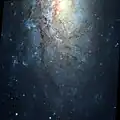NGC 3621
NGC 3621 is a field spiral galaxy about 22 Mly (6.7 Mpc) away[4][6] in the equatorial constellation of Hydra. It is comparatively bright and can be well seen in moderate-sized telescopes. The galaxy is around 93,000 ly (29,000 pc) across and is inclined at an angle of 25° from being viewed edge on. It shines with a luminosity equal to 13 billion times that of the Sun.[7] The morphological classification is SA(s)d,[1] which indicates this is an ordinary spiral with loosely wound arms.[8] There is no evidence for a bulge.[9] Although it appears to be isolated,[8] NGC 3621 belongs to the Leo spur.[7]
| NGC 3621 | |
|---|---|
 NGC 3621 taken by the Wide Field Imager (WFI) at ESO's La Silla Observatory | |
| Observation data (J2000 epoch) | |
| Constellation | Hydra |
| Right ascension | 11h 18m 16.52s[1] |
| Declination | –32° 48′ 50.7″[1] |
| Redshift | 0.002435 ± 0.000007[2] |
| Heliocentric radial velocity | +727[3] km/s |
| Distance | 21.7 million light years (6.64 Mpc)[4] |
| Apparent magnitude (V) | 10.0 |
| Characteristics | |
| Type | SA(s)d[1] |
| Mass | 2 × 1010[1] M☉ |
| Other designations | |
| UGCA 232, MCG -05-27-008, PGC 34554[5] | |
This galaxy has an active nucleus that matches a Seyfert 2 optical spectrum, suggesting that a low mass supermassive black hole is present at the core. Based upon the motion of stars in the nucleus, this object may have a mass of up to three million times the mass of the Sun.[9]
Gallery

 Very Large Telescope image of NGC 3621.[11]
Very Large Telescope image of NGC 3621.[11] NGC 3621 by Hubble Space Telescope
NGC 3621 by Hubble Space Telescope NGC 3621 by GALEX
NGC 3621 by GALEX Spitzer Space Telescope image of NGC 3621.
Spitzer Space Telescope image of NGC 3621. NGC 3621 (HST)
NGC 3621 (HST)
References
- Bresolin, Fabio; Kennicutt, Robert C.; Ryan-Weber, Emma (May 2012), "Gas Metallicities in the Extended Disks of NGC 1512 and NGC 3621. Chemical Signatures of Metal Mixing or Enriched Gas Accretion?", The Astronomical Journal, 750 (2): 122, arXiv:1203.0956, Bibcode:2012ApJ...750..122B, doi:10.1088/0004-637X/750/2/122, S2CID 118616035.
- Koribalski, B. S.; et al. (July 2004), "The 1000 Brightest HIPASS Galaxies: H I Properties", The Astronomical Journal, 128 (1): 16–46, arXiv:astro-ph/0404436, Bibcode:2004AJ....128...16K, doi:10.1086/421744, S2CID 16229767.
- Tully, R. Brent; Shaya, Edward J.; Karachentsev, Igor D.; Courtois, Hélène M.; Kocevski, Dale D.; Rizzi, Luca; Peel, Alan (January 1995), "Recalibration of the H–0.5 magnitudes of spiral galaxies", Astrophysical Journal Supplement Series, 96 (1): 123–157, arXiv:astro-ph/9405047, Bibcode:1995ApJS...96..123T, doi:10.1086/192115, S2CID 15737426.
- Tully, R. Brent; et al. (March 2008), "Our Peculiar Motion Away from the Local Void", The Astrophysical Journal, 676 (1): 184–205, arXiv:0705.4139, Bibcode:2008ApJ...676..184T, doi:10.1086/527428, S2CID 14738309.
- "NGC 3621". SIMBAD. Centre de données astronomiques de Strasbourg. Retrieved 2021-02-24.
- Materne, J. (April 1979). "The structure of nearby groups of galaxies - Quantitative membership probabilities". Astronomy and Astrophysics. 74 (2): 235–243. Bibcode:1979A&A....74..235M.
- O'Meara, Stephen James (2013), Deep-Sky Companions: Southern Gems, Cambridge University Press, p. 203, Bibcode:2013dcsg.book.....O, ISBN 978-1107015012.
- Buta, Ronald J.; Corwin, Harold G.; Odewahn, Stephen C. (2007), Atlas of Galaxies, Cambridge University Press, pp. 13–17, ISBN 978-0521820486.
- Barth, Aaron J.; Strigari, Louis E.; Bentz, Misty C.; Greene, Jenny E.; Ho, Luis C. (January 2009), "Dynamical Constraints on the Masses of the Nuclear Star Cluster and Black Hole in the Late-Type Spiral Galaxy NGC 3621", The Astronomical Journal, 690 (1): 1031–1044, arXiv:0809.1066, Bibcode:2009ApJ...690.1031B, doi:10.1088/0004-637X/690/1/1031, S2CID 12574940.
- "A special spiral galaxy for over 200 000 Facebook fans". Hubble Space Telescope – Picture of the Week. Retrieved 23 January 2020.
- "A galaxy full of surprises — NGC 3621 is bulgeless but has three central black holes". European Southern Observatory – Picture of the Week. Retrieved 23 January 2020.
External links
- A Picture-perfect Pure-disc Galaxy — ESO Photo release.